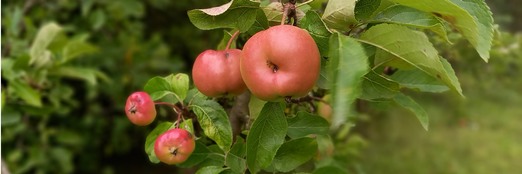

Biodiversity
Action
Plan
The fruit trees in Traditional Orchards are generally planted further apart and can grow to a good size with a more open, spreading form, unlike the short-lived or dwarf varieties found in commercial orchards.
The spacing of the trees and range of tree ages in a well established orchard, provide varied light conditions, shelter and food. Many species rely on the unique structure and microclimates provided there.
Fruit trees age more quickly than most British hardwoods and provide deadwood habitats. Crevices and hollows may provide nesting sites for birds such as Spotted Flycatchers and roosts for many species of bat. These veteran tree features support a range of saproxylic (deadwood- dependent) insects and the nutrient-rich bark of many fruit trees, combined with the variation in light and shade, supports epiphytic mosses and lichens.
There are usually many varieties of fruit trees in a given block leading to an extended period of flowering and fruiting, which benefits insects in pollination, birds like thrushes which feed on the fruit, and mammals such as hedgehogs as well as a variety of invertebrates.
The ground vegetation is most commonly some kind of neutral grassland, often either unimproved or only semi- improved, and may be species-rich. The soil in orchards is left undisturbed with its structure largely intact, creating the conditions for certain plants, including native orchids. A variety of grassland sward lengths provide more opportunities for invertebrates to find food and shelter.
The hedges surrounding orchards not only protect the fruit trees from frost and wind damage but also provide additional habitats for wildlife. The best hedges for orchard wildlife consist of mixed native species with an untended margin at the base. These provide an additional nectar source of value to invertebrates.
Species supported by traditional orchards in Barnsley
Bat species make use of the crevices and hollow rot holes of veteran fruit trees for roosting,. They may include Noctule, Daubenton’s, Brown long-eared, Leisler’s and Natterer's Bat, Other species may also be found foraging, including Pipistrelle Bats.
Other mammals found in traditional orchard habitats include Badger, Fox and Hedgehog as well as mice, voles and shrews.
Bird species
Traditional orchards are a good habitat for many bird species including hole nesting species and species of gardens and woodland edge. Birds feed on the fruit and on the insect population of orchards.
Bird species found in traditional orchards include: Bullfinch, Hawfinch, House Sparrow, Grey Partridge, Lesser-spotted woodpecker, Linnet, Song Thrush, Spotted Flycatcher, Starling, Tree Sparrow, and Yellowhammer as well as Fieldfare and Redwing in winter.
Reptiles and amphibians include Grass snake, Common Toad and Frog.
Invertebrates
The older fruit trees support a range of specialist invertebrates. Other invertebrates benefit from the range of habitats found in traditional orchards including the grasses, flowering plants and fruit blossom.
Trees
The most common local fruit tree species are Apple and Pear. Plum , Damson, and Cherry are also planted with occasional Cobniut (Hazel).
Habitat Features of Traditional Orchards
The best traditional orchard priority habitat consists of grazed grassland with fruit trees of varying age structure. The combination of fruit trees, the grassland floor, fallen and standing deadwood, hedgerow boundaries and scrub, and associated features such as ponds and streams, mean that traditional orchards offer a mosaic of different habitats, which support plant diversity and a range of wildlife species.


Traditional Orchard Features